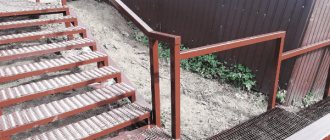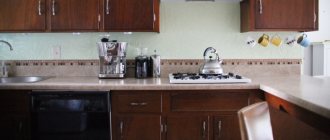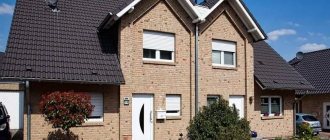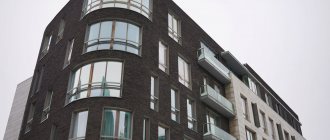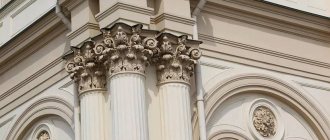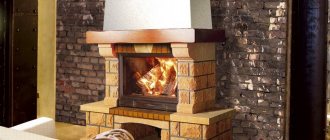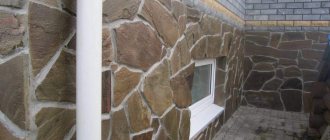From a purely technological point of view, finishing the facade of a house with brick is a rather complex and expensive undertaking. Nevertheless, a huge number of individual developers choose this technology for themselves. Any house can be faced with brick, not only a stone one, but also a log house and even a frame structure. Yes, the modern development of the construction industry has significantly expanded the possibilities for exterior decoration of houses, but brick continues to firmly occupy its niche. The shape and texture recognizable from childhood, solidity and solidity, reliability and durability - the combination of these characteristics inherent in brick houses creates a special value for buyers.
It should be understood that brick cladding is a finishing method that places increased demands on both the quality of the material and the qualifications of the performers, as well as compliance with technological requirements. Today, together with specialists and with the participation of users of our portal, we will look at the basic rules for choosing facing bricks, talk about the features of laying a brick facade and analyze the main problems that buyers face.
What is facing brick?
From the name it follows that the material is used for cladding a house. They are also called front or façade, but this does not mean that manufacturers relegate strength characteristics to the background.
The brick used to decorate the walls outside must also have good strength indicators. This is due to the fact that the facade is constantly exposed to serious loads, such as:
- Mechanical damage (shocks, gusts of wind).
- Changes in ambient temperature.
- Atmospheric precipitation, which means regular high humidity.
- Ultraviolet radiation.
- Biological effects (mold, fungus, insects, rodents).
Thanks to special manufacturing technologies, a brick facade is able to withstand all the above loads. At the same time, the material retains its attractive appearance for a long time without unnecessary maintenance costs.
What are the characteristics of concrete products?
Facing concrete bricks can have one or two front surfaces - smooth or textured.
produces high-quality products with ideal geometry, in different colors: straw, red, gray, light brown, brown, black.
For the manufacture of our products we use:
- Portland cement grades M400 and M500;
- sand cleared of clay inclusions;
- fine crushed stone with a grain size of up to 10 mm;
- purified water;
- additives to improve performance;
- coloring pigments.
Our facing products are characterized by:
- Good insulating properties. The products provide high heat, noise and waterproofing of the internal space.
- Resistance to damage by fungi and insects.
- High fire resistance. Thanks to this valuable characteristic, concrete facing bricks can be used for laying areas located near chimneys and fireplaces.
- High water resistance and frost resistance.
- Good environmental and hygienic characteristics. The material does not accumulate radiation and does not emit toxic substances.
- Good machinability. If necessary, holes and grooves can be made in such bricks for laying utility lines.
Advantages and disadvantages of this finish
When choosing materials for decorating a facade, you should definitely study all the pros and cons of one or another option. Consult with professionals, contact home owners who have chosen the same finish and know how the material behaves. Internet forums are also suitable. It is advisable to visit third-party sites, and not the online store of any manufacturer.
As for brick cladding, the following advantages are highlighted:
- High moisture repellency.
- Durability and reliability.
- Frost resistance of the structure.
- Vapor permeability.
- Fire and environmental safety.
- Long service life of 50 years.
- Self-cleaning - dust and dirt are washed away by rainwater.
- Easy care.
- Versatility of use - suitable for both outdoor and indoor decoration.
- Large selection of shades and factor.
Of course, there are several disadvantages, like any other finishing material. Let's get acquainted with them:
- High price.
- Low-quality products are covered with a white coating (efflorescence).
- It is important to buy the right amount of bricks from one batch, otherwise the elements will differ in color. Although some people specifically buy 2-3 shades and mix the elements during the styling process. Thus, a unique pattern is created on the facade.
After evaluating the information received, everyone decides for themselves whether this option is suitable or not.
Main Dimensions
The dimensions of domestically produced facing bars are determined by GOST 530-2007, which divides the dimensions of products as follows:
- single brick - 250x120x65 mm;
- one and a half - 250x120x88;
- double - 250x120x138;
- narrow - 250x60x65;
- thin - 250x22x65.
The document gives the manufacturer the right to produce products of other standard sizes as agreed with the buyer. In addition to rectangular bars, cladding material is produced in various curly rounded shapes for laying out arches, frames, and fillets.
ATTENTION: EU countries produce products according to their own standards; the brick has a thickness reduced by 0.7.
When is it possible and when not to cladding walls with brick?
But there are several points that do not allow the use of brickwork:
- Low foundation strength. Brick is still a heavy material and requires a reliable foundation. Therefore, if at first it was planned to build a frame house with a light cladding, but during operation it was decided to make the cladding out of brick, then you will have to build an additional foundation exclusively for the finishing wall.
- Affects the choice of cladding and the strength of the load-bearing wall. The vertical brick is connected to the supporting structure so that it does not fall to one side or the other. This means that the main wall must withstand additional load. A gas silicate base is suitable.
- The need to remodel the roof also weighs heavily when choosing a brick facade. The finished roof will not be able to protect the new structure.
All these nuances significantly increase the price of an already expensive cladding. If the house is old and cannot withstand such loads, then it is better to use lighter options for repairs, for example, basement siding with imitation brick or ceramic tiles for the facade. A curtain façade is used.
It is better if the brick facade is included in the design of the new house. Then, when constructing a facing wall according to the drawing, unexpected costs or situations will not arise. Plus, when everything is planned and executed correctly, the structure will be much stronger.
conclusions
Cladding a façade with brick is a labor-intensive undertaking. But if you follow the technology, use high-quality bricks and additional materials, and use the services of professional builders, then such a facade will last at least 100 years.
If you want to learn more about brick facades, possible problems and ways to solve them, read our article.
FORUMHOUSE has a topic dedicated to the choice of facing bricks and experience in using brick facades.
Subscribe to our Telegram channelExclusive posts every week
Types of bricks for wall cladding
The modern building materials market offers types of facing bricks that differ in the composition of the original components and production method. But this does not mean that the technical characteristics are different. All values are located approximately at the same level. Only the appearance and colors differ. Therefore, we will consider several popular options.
Ceramic
The main raw material for the manufacture of such bricks is clay of different grades. Several additional substances are added to the main component, which slightly improve its quality. The material is created solid or with cavities. Strength does not depend on the presence of cavities; rather, the thermal insulation function improves.
They mainly offer a range of shades from brown to orange and yellow, which is related to the raw materials. No dye is added to this type of brick. The surface of the elements can be glossy or matte. Production features are as follows:
- Thorough mixing of all components, especially if several types of clay were used.
- Molding of blanks.
- Firing at a temperature of 800–1000 degrees.
But even if the same type of clay is used, the shade of individual elements differs, and this is due to the following factors:
- Insufficient quality batch.
- Raw materials from the same quarry often differ in composition and color.
- Temperature fluctuations. The higher the workpieces were heated, the darker the brick would turn out.
- The duration of heat treatment is the same dependence as in the previous version. The longer it burns, the darker it gets.
The disadvantage of ceramic bricks is the frequent occurrence of efflorescence. The presence of such white spots is associated with low-quality raw materials or short firing time. The composition of the adhesive is also an influential factor. For the solution, select only high-quality components.
Clinker
This is another version of ceramic brick, but differs from its predecessor in the following manufacturing aspects:
- Only refractory types of clay are selected.
- Pigments are added to the mix, which allows you to make bricks of different colors.
- After formation, firing is performed at higher temperatures of about 1300 degrees. The material becomes durable and can withstand significant loads.
Clinker has decorative properties, but is also expensive. Everything is connected with a complex production process. In addition, the domestic market mainly presents goods from foreign manufacturers. Russian manufacturers still do not meet quality standards.
Hyper-pressed
This brick consists mainly of waste from various industries:
- limestone;
- shell rock;
- waste from processing natural stones;
- slags
In order to bind all the components, add a little cement. To obtain colored ones, mineral and natural pigments are used. Hyper-pressed brick is distinguished by the process of creating products:
- Thoroughly knead the dry ingredients.
- Moisten the mixture with a small amount of water.
- Packaging in forms.
- Exposure to high pressure.
The workpieces are dried until the moisture completely disappears. As you can see, the firing process is completely absent, but this does not make the brick brittle. On the contrary, thanks to the binder, the material acquires the same strength as natural stone. Hyperpressed cladding costs a little less than clinker or ceramics, since the technological process is simpler.
The dimensions of the parts are almost identical, which is difficult to achieve when creating previous versions. This means that it is easier to cover the façade with such material. The front side of the brick resembles torn stone, as it is chipped and broken. This texture only attracts buyers, because it is an imitation of natural stone.
Silicate
To make this option, clay is not used at all. Manufacturers choose the main components:
- Quartz sand.
- Lime.
- Pigments.
- Mineral supplements.
Before sending the blanks for firing at a temperature of 120–200 0 C, they are pressed. Such actions allow you to give the parts the correct shape with small errors in size (up to 0.5 mm). It is worth saying that sand-lime brick is also fired at increased pressure up to 12 atmospheres.
This material is much cheaper than the above types. But they are rarely used as facade cladding. This is related to:
- High moisture absorption.
- Low resistance to ultraviolet radiation.
- Poor reaction to negative ambient temperatures.
If this option is chosen for finishing, care is taken to protect it from destructive factors. The facade is treated with moisture-repellent compounds and the roof overhang is increased.
How much does it cost
The cost of cladding material depends on the type, characteristics and location of the manufacturer.
The cheapest option is lining with white silicate bars: raw materials for production are available everywhere, the steaming installation does not take up much space, and energy costs are low. The price of white sand-lime brick starts from 9 rubles/piece.
Ceramic facing bricks have a wide range in cost: products from the Revda plant (Ural) from 8 rubles/piece. up to 78 RUR/pcs. imported production.
The cost of clinker starts from 70 rubles/piece. produced in the Russian Federation up to $254 per m2 of Quebec clinker, size 230x105x71, white.
Prices for hyper-pressed material start from 12.5 rubles/piece. for a narrow format (actually 22 mm thick tiles, up to 71 rubles/piece for a one-and-a-half-size product.
What is Bavarian masonry?
As mentioned above, bricks from different batches differ significantly in color. In the 17th century, the Bavarians also faced this problem. They tried to select raw materials more carefully and constantly improved the manufacturing process, but nothing worked.
Then it occurred to me to sort the finished products by color. Unfortunately, the desired result also did not happen. There was nothing left to do but mix all the elements of 2-4 shades and distribute them evenly over the façade so that light or dark areas do not form on the surface.
Builders noticed that houses with such a pattern looked no worse than plain buildings. In addition, the masonry gave the building brightness and attractiveness, making it stand out from the crowd. Now this style of bricklaying is considered a sign of good taste, and tourists go to Bavaria to admire the ancient buildings.
Useful tips from the master
- You cannot lay more than 5 rows of bricks at a time; due to the heavy weight, the masonry may bend;
- Every three rows the masonry must be checked with a level;
- Do not remove the scaffolding immediately after completing the masonry; leave it for grouting;
- Be sure to leave a gap between the wall and the facade. This will not only rid the building of moisture, but also insulate it.
- A connection must be made between the wall of the house and the facade. Typically, metal mesh, perforated metal strips, wire and anchors are used for this.
Finishing the facade with brick is a great idea for a new home. High-quality modern brick will not only make your home attractive, but will strengthen your walls and make your home warmer. You can entrust the installation to professional masons or do it yourself, following our advice.
Examples using bricks
Some people like brickwork, and the owner strives to recreate such a facade in any way - using facing bricks or materials that can imitate this cladding. Others try to escape from the standards and disguise brick walls in any known way.
There is no arguing about tastes, since everyone has their own vision of beauty. Therefore, we will consider several options for facades decorated with brick, but in different interpretations and styles.
Universal brick facade
Brick is such a versatile material that it is even used to decorate houses with columns, arches, stucco molding and other facade decor. At the same time, the building will not lose its attractiveness, but on the contrary, it will sparkle with new colors, and at the same time it will not look vulgar or tasteless.
A correctly selected shade of cladding elements, as well as texture, will only emphasize the taste and status of the owner of the house. Therefore, when turning to brickwork as a renovation of the facade, you should not worry about whether the building will be as beautiful. No, it won’t, but it will become completely new!
Painted brick, external walls of different colors
With the help of paints and varnishes they transform a brick facade that has already become boring. But be careful when choosing this method of decorating a private building. The paint penetrates deeply and unevenly into the structure of the brick, and it will be extremely difficult to get rid of it.
As you know, paint is not a material with a long service life, therefore, having painted a brick facade once, it must be maintained in an attractive form every 3-5 years, depending on the type of paint chosen. In addition, some types cover the facade with a durable film that does not allow moisture to pass through from the interior. This will negatively affect the base material.
If this option is suitable and does not frighten the owner, then there are no limits to imagination. On the construction market there are a large number of facade paints that are already tinted or white, which can be pigmented. The pigment is chosen from the same manufacturer as the paint.
No more than three shades are combined on the façade. Contrasting colors are used to highlight window and door openings, porches, and decorative elements. To choose a color scheme, use advice from fashionable construction publications, their online counterparts, or professional designers.
All options have photo galleries where you can select a ready-made option or create a completely new one at the request of the client. It is quite possible to do the painting yourself, but if the building is large, two-story, then it is better to resort to the services of a professional team with the appropriate tools and equipment.
Whitewashed brick
One of the options for painting the facade is to apply whitewash to the brick. This method of decorating exterior houses will achieve an aged effect. Whitewashing of bricks was often used in English villages, so those who are interested in this style cannot do without whitewash.
For whitewashing, a mixture of lime and table salt is used. If you add a small amount of white cement, the layer will be more durable and will last longer.
Energy efficient brick
The energy efficiency of this material lies in the ability to heat up for a long time, and then release heat to the environment for a long time. Thus, we have the following:
- In the summer, the facade warms up in the sun, but the heat does not penetrate into the rooms, so it remains cool there.
- In winter, heated internal walls do not let heat out, but at the same time retain heat inside the rooms for a long time.
Buildings with a long service life require wall insulation. Therefore, when laying decorative bricks, a small gap is left between the main and outer (decorative) walls. Insulating material is placed in this gap, taking into account the ventilated gap.
If this is not done, moisture will accumulate in the thermal insulation material, which will lead to destruction. In addition, the walls inside the rooms will also be damp. And if you leave a gap, then there is no need to additionally ventilate the room.
Natural beauty
Synthetic materials are rarely used to make facing bricks. Therefore, such cladding remains natural and absolutely safe for human health, as well as for the environment. If dyes are added to create brightly colored finishes, they are most likely of natural mineral origin.
Naturalness is always in fashion, and now, when the world around us is stuffed with synthetic substances, I want to lock myself in a country cottage or a city one-story house made from natural ingredients.
Playing with texture
Brick goes well with different materials that have an original texture. It makes no difference whether there are wooden tiles or decorative elements on the metal façade, a stone path or a plinth and corners trimmed with stone. The brick facade will emphasize the originality of the finish.
You can finish several elements with plaster and leave a clean facade, which looks good. In addition, bricks of different types and shades combine well on one house. You just need to skillfully select a separate area.
Mix tiles and bricks
If there is a large amount of green space around a house with an attic, then untreated brick is suitable as a finishing for the facade. The roof is covered with unpainted tiles. This method of decorating the facade will create coziness throughout the entire area and convey the spirit of the forest thicket.
Handmade brick
Now all bricks are made in factories and in large batches. Previously, everything was done manually without the use of sophisticated equipment. If you want to make your house stand out from the general mass of buildings, you can do everything the old fashioned way.
Mix the solution, pour into wooden molds and fire over a fire. By washing away the unevenness on the bricks with sand, they create an original velvety texture. Such blocks will aesthetically embellish the facade and convey the spirit of an ancient mansion.
Modern brick
The versatility of the brick facade allows it to be used for modern buildings in the minimalist style. Various colors and textures are suitable for creating an accent both on the facade and indoors. In addition, there is nothing wrong with completely covering the facade.
Styles of facades of brick houses
Centuries of using brick as a building and facing material have led to the emergence of many methods and styles of building design, resulting in beautiful brick facades of private houses; we offer photos of different styles below. There are several popular trends in decorating modern brick houses:
- English style . The most popular cottages are those whose facades are made of red brick, although a house made of brown brick will not violate the canons. The direction is characterized by clear geometric shapes, restraint in palette and decor, precise proportions and a small, neat porch. Modern English houses still do without a basement, but the attic is an indispensable component of the look.
- Gothic style . A country cottage in the Gothic style is a personal fortress with all (unlike its medieval predecessors) amenities and external attributes: strict lines of the facade, forged elements and a facade lined with brick. The rougher the material, the more brutal the building looks. The brick can be any color; To enhance the effect, the color of the roof and trim is selected in contrast.
Brick cottage in Provence style Source pinterest.com
- Country or Provence . Both styles bear the features of free country life and look cozy and elegant; In design, brick is often combined with plaster and wood. It is traditional to distinguish brick facades by shades. For houses in the Provence style, cold tones (gray, bluish, white) are often chosen; for country-style facades, warm colors are chosen, from delicate beige and ivory to rich curry.
- European style . It combines traditions from several European countries, including Germany, Denmark, Austria and the Netherlands. Most often, the facades of European-style cottages combine elements of half-timbering (medieval technology) with stone, plaster and brick. The facades of houses with gray and light bricks look practical and respectable.
European style - fabulously cozy and practical Source natelki.net
- Historical direction . Brick facades of houses, made in Romanesque or classical style, Rococo, Baroque or Art Nouveau style, look luxurious and majestic, but require the involvement of an experienced architect who can maintain the correct proportions and overall design.
- Modern styles . These include constructivism, minimalism, hi-tech and eclecticism, which is fashionable today. The facades of such houses have their own characteristics and can be decorated in a thousand different ways, and brick will look appropriate everywhere. In exterior design, brick facades are often painted. This can be done on brick, immediately after the masonry has dried, or after plastering the surface.
Modern project - brick cladding and panoramic glazing Source pinterest.ru
Is it worth doing the cladding yourself?
The process of laying bricks is quite complex. Without experience in this field, it is almost impossible to make a smooth wall horizontally and vertically. Moreover, there are also features of the formation of an external decorative wall. It is necessary to make flexible connections and leave ventilation gaps between the elements. It is very difficult to control everything. In addition, the work will not go quickly.
Therefore, you should not tempt fate and transfer expensive bricks and mortar, but immediately hire a professional team of masons. Finding good workers will also be difficult. Check with your friends or neighbors, maybe there are people like them in their circle. And be prepared for the fact that the cost of performing the work is also not cheap.
Required Tools
The following tools are used for laying bricks:
- Trowel (trowel);
- Construction cord;
- Plumb;
- Level;
- Rule;
- Roulette;
- Small hammer-pick;
- Putty knife;
- Grinder for cutting bricks;
- Construction mixer;
- Hammer;
- Joint jointer (narrow tool for laying mortar for joints);
- Containers for diluting mortar and wetting bricks.
Marking
Facing bricks are marked using an alphanumeric designation. The larger the number in the product name, the better its characteristics:
| Options (brown, red) | Unit | Fas. M-100 products | M-125 | m-150 |
| Compressive strength limit | kgf/cm2 | 100-120 | 130-145 | 155-170 |
| Flexural strength limit | kgf/cm2 | 16-18,5 | 19-20,5 | 21-22,5 |
| Water absorption | % | 8,5-10,5 | 8,5-10,5 | |
| Average density | kg/m2 | 1100-1280 | 1180-1230 | |
| Thermal conductivity | W/(m-K) | 0,37 | 0,37 | |
| Frost resistance | cycle | 50-100 | 50-100 | |
| Emptiness | % | 36-38 | 36-38 | |
| Product weight | kg | 1,500-2,300 | 2,300-2,400 | |
| Dimensions | mm | 250x120(65)x65 | 250x120x65 | |
| Number of bricks on a pallet | PC. | 480 | 480 | |
| Dimensions of packaging | mm | 1000x1000 | 1000x1000 | |
| Parameters (dark peach, light peach, cream) | Unit | Fas. M-100 products | M-200 | M-250 |
| Compressive strength limit | kgf/cm2 | 100-120 | 210-230 | 255-300 |
| Flexural strength limit | kgf/cm2 | 16-18,5 | 25-28,5 | 29-33 |
| Water absorption | % | 8,5-10,5 | 5,5-7,0 | |
| Average density | kg/m2 | 1100-1280 | 1255-1280 | |
| Thermal conductivity | W/(m-K) | 0,37 | 0,37 | |
| Frost resistance | cycle | 50-100 | 50-100 | |
| Emptiness | % | 36-38 | 36-38 | |
| Product weight | kg | 1,500-2,300 | 2,450-2,500 | |
| Dimensions | mm | 250x120(65)x65 | 250x120x65 | |
| Number of bricks on a pallet | PC. | 480 | 480 | |
| Dimensions of packaging | mm | 1000x1000 | 1000x1000 | |
